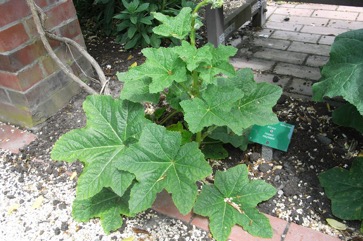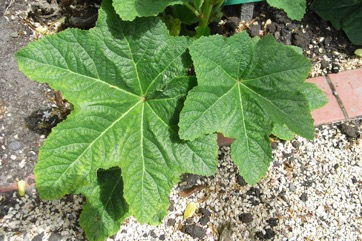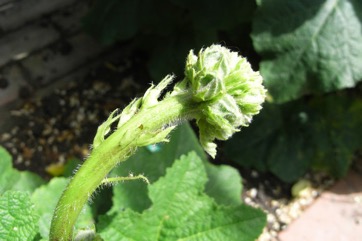Hollyhock

It is a temperate plant. Plants are frost hardy. Plants can tolerate temperatures down to about -15°C. It grows best in a sheltered sunny position and in a heavy rich soil. It will grow in most soils. It is resistant to frost but sensitive to drought. The soil should be well drained. It suits hardiness zones 3-10. In Yunnan.
Also known as:
Dulhatma, Malva real, Malvavisco, Mandinhhong, Rožlin, Rubeerwa, Shu kui, Sichuan Kui, Thucquy
Synonyms
- Alcea biennis Winteri
- Alcea ficifolia Nyman
- Althaea caribea Sims
- Althaea chinensis Wall.
- Althaea rosea (L.) Cav.
- and others
Edible Portion
- Flowers, Leaves, Roots, Stem
Where does Hollyhock grow?
Found in: Africa, Argentina, Asia, Australia, Bosnia, Britain, Bulgaria, Chile, China, Cuba, Dominican Republic, East Africa, Egypt, Europe, Haiti, India, Indochina, Iraq, Japan, Korea, Kurdistan, Mozambique, New Zealand, North Africa, North America, Pakistan, Puerto Rico, SE Asia, Serbia, Slovenia, Southern Africa, South America, Spain, Tasmania, Thailand, Turkey, United States, Vietnam, West Indies, Zimbabwe
Notes: There are about 60 Alcea species. This one is used in medicine.
Growing Hollyhock
Cultivation: Plants can be grown from seed, division of the clump or by cuttings. Seeds germinate in 2-3 weeks at 20°C. To avoid frosts seeds are sown indoors 8 weeks before the last frost. The seed are sown 6 mm deep. It should be pruned back after flowering.
Edible Uses: The young leaves are eaten raw or cooked. The leaves are used for sarma in Turkey. They are rolled around a filling of rice or minced meat. The inner portion of the young stems is eaten raw. The flowers buds and petals are added raw to salads. An edible starch can be made from the root. The flower petals can be used for tea.
Nutrition Info
per 100g edible portion| Edible Part | Energy (kcal) | Protein (g) | Iron (mg) | Vitamin A (ug) | Vitamin c (mg) | Zinc (mg) | % Water |
|---|---|---|---|---|---|---|---|
| Leaves | - | - | - | - | - | - | |
| Stems | - | - | - | - | - | - | |
| Flowers | - | - | - | - | - | - | |
| Root - starch | - | - | - | - | - | - |
Hollyhock Photos



References
Ambasta S.P. (Ed.), 2000, The Useful Plants of India. CSIR India. p 33 (As Althaea rosea)
Bircher, A. G. & Bircher, W. H., 2000, Encyclopedia of Fruit Trees and Edible Flowering Plants in Egypt and the Subtropics. AUC Press. p 21 (As Althaea rosea)
Bodkin, F., 1991, Encyclopedia Botanica. Cornstalk publishing, p 72 (As Althaea rosea)
Bremness, L., 1994, Herbs. Collins Eyewitness Handbooks. Harper Collins. p 145
Brown, D., 2002, The Royal Horticultural Society encyclopedia of Herbs and their uses. DK Books. p 110
Burnie, G.(Ed.), 2003, Annuals and Bulbs. The Gardener's Handbooks. Fog City Press p 116
Cordero, S. E., Abello, L. A., & Galvez, F. L., 2017, Plantas silvestres comestibles y medicinales de Chile y otras partes del mundo. CORMA p 137
Cundall, P., (ed.), 2004, Gardening Australia: flora: the gardener's bible. ABC Books. p 123
Dogan, Y., et al, 2015, Of the importance of a leaf: the ethnobotany of sarma in Turkey and the Balkans. Journal of Ethnobiology and Ethnomedicine, 11:56
Dashorst, G.R.M., and Jessop, J.P., 1998, Plants of the Adelaide Plains & Hills. Botanic Gardens of Adelaide and State Herbarium. p 102
Facciola, S., 1998, Cornucopia 2: a Source Book of Edible Plants. Kampong Publications, p 147
Flora of Pakistan. www.eFloras.org
Hedrick, U.P., 1919, (Ed.), Sturtevant's edible plants of the world. p 47 (As Althaea rosea)
Joyce, D., 1998, The Garden Plant Selector. Ryland, Peters and Small. p 312
Lamberton, K (Ed.), 2004, The Australian gardening encyclodepia. Murdoch Books, NSW Australia. p 155
Liu, Yi-tao, & Long, Chun-Lin, 2002, Studies on Edible Flowers Consumed by Ethnic Groups in Yunnan. Acta Botanica Yunnanica. 24(1):41-56 (As Althaea rosea)
McMakin, P.D., 2000, Flowering Plants of Thailand. A Field Guide. White Lotus. p 27 (As Althaea rosea)
Plants for a Future database, The Field, Penpol, Lostwithiel, Cornwall, PL22 0NG, UK. http://www.scs.leeds.ac.uk/pfaf/
Plants of Haiti Smithsonian Institute http://botany.si.edu/antilles/West Indies
Redzic, S. J., 2006, Wild Edible Plants and their Traditional Use in the Human Nutrition in Bosnia-Herzegovina. Ecology of Food and Nutrition, 45:189-232 (As Althaea rosea)
Redzic, S., 2010, Use of Wild and Semi-Wild Edible Plants in Nutrition and Survival of People in 1430 Days of Siege of Sarajevo during the War in Bosnia and Herzegovina (1992–1995). Coll. Antropol 34 (2010) 2:551-570
Valder, P., 1999, The Garden Plants of China. Florilegium. p 349
Vermeulen, N, 1998, The Complete Encyclopedia of Herbs. Rebo Publishers. p 31